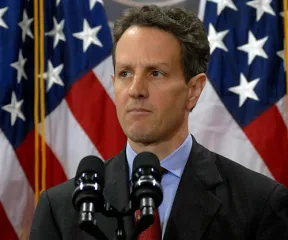- | Financial Markets Financial Markets
- | Expert Commentary Expert Commentary
- |
What Not to Do During a Financial Crisis
As its title suggests, Timothy Geithner’s book, "Stress Test," is stressful reading. The former treasury secretary returns the reader to the terrifying days of the 2007-2009 financial crisis. Those memories on their own are bad enough, but Geithner’s contemporaneous thoughts and words are the really scary part.
As its title suggests, Timothy Geithner’s book, "Stress Test," is stressful reading. The former treasury secretary returns the reader to the terrifying days of the 2007-2009 financial crisis. Those memories on their own are bad enough, but Geithner’s contemporaneous thoughts and words are the really scary part.
Geithner, a man who does not sit still, was a fierce advocate for more government action during the crisis — more bailouts, bigger government guarantees and new programs. “No more Lehmans” is the book’s anthem. Anything to let the markets know that the government would not let private financial institutions fail or even stumble. Geithner’s defense of his motives for acting, however, is more convincing than his defense of the substance of those actions.
Many pages are dedicated to decoding the acronyms of the actions the government took (all with Geithner’s enthusiastic support) — TLGP, AMLF, CPFF, TAF, TALF, TARP, TSLF, HAMP, HARP, PPIP, and the list goes on. Much of the rest of the book is a lament for the tools the government did not have. “Neither the Fed nor the Treasury had authority to inject capital into troubled institutions except Hank [Paulson]’s new power to invest in Fannie and Freddie. We had only limited tools to defend against a run on firms outside the commercial banking system,” he writes. If only the government had more tools — or better yet, carte blanche — to save the financial system.
